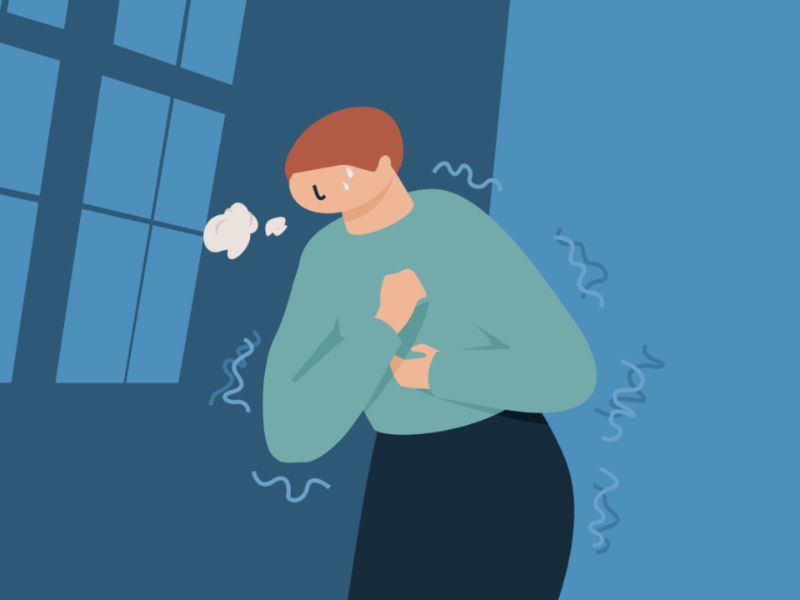Everyone occasionally feels anxious, scared, or stressed. It is a human being's instinctive reaction to frightening or hazardous situations. However, some people worry more often than others, seemingly for no cause. Sudden and overwhelming panic episodes are possible. Knowing what to do when they occur can help lessen their impact or even put a halt to them.
The sudden onset of a severe feeling of dread or extreme nervousness is known as a panic attack. These feelings of terror and dread typically come on suddenly and are out of proportion to any real threat or peril.
Panic attacks frequently end quickly. But after the original attack, the effects of panic attack can linger for several hours. The most frequent sign connected to the diagnosis of panic disorder is panic attacks. However, they can also be a symptom of a number of mood and anxiety problems, in addition to other illnesses. Additionally, panic attacks can occur in reaction to particular occasions or demanding circumstances.
Panic attacks can create various physical and emotional symptoms
Physical symptoms of Panic Attack may include:
- Sweating
- Rapid breathing
- Pounding pulse
Emotional symptoms of Panic Attack may include:
- Feelings of fear and anxiety
- Intense, repetitive worrying
- A feeling of impending doom
Typically, panic attack symptoms start out suddenly and peak in a matter of minutes. After a panic attack has passed, the symptoms may completely disappear or the person may continue to feel anxious, potentially going through the panic cycle once more.
Are all panic attacks the same?
Not every panic attack is felt in the same manner. One classification for panic episodes is as follows:
- Panic strikes that were anticipated: These assaults happen when a person is exposed to or is preparing for a specific trigger. For instance, a person who is afraid of heights might experience a panic attack inside a tall structure.
- Situationally predisposed panic attacks: These attacks resemble cued panic attacks but do not always happen when a feared scenario is encountered. Additionally, these assaults don't always take place when the victim is exposed to the trigger. For instance, a person who is afraid of aircraft might not always experience panic attacks in flight or might experience them later.
- Panic attacks that come on abruptly and without warning (uncued): These attacks have neither internal nor external cues.
Prevention of Panic Attacks
There are a number of methods to stop or control panic attacks:
- Utilize calming methods: Effective techniques for lowering tension and fostering relaxation include deep breathing, progressive muscle relaxation, and meditation. The regular application of these methods can aid in preventing panic episodes.
- Regular exercise: Stress and anxiety, which are frequent causes of panic attacks, can be lessened with exercise. Regular exercise can lower the chance of getting anxiety disorders and enhance overall mental health.
- Avoid triggers: Recognize and stay away from circumstances or stimuli that cause panic episodes. In addition to avoiding stressful or anxiety-inducing circumstances, this may entail abstaining from caffeine, alcohol, or specific medications.
- Get enough rest: Sleep deprivation raises the danger of panic attacks. Maintain a regular sleep routine and make sure you get enough sleep each night.
- Self-care is important: Eating well, exercising frequently, and engaging in stress-relieving tasks can all help you avoid panic attacks. Prioritize your physical and mental wellbeing, and get assistance if necessary.
Treatment of Panic Attacks
Due to panic attacks, an individual with panic disorder may be severely limited. For instance, they might spend a lot of time fretting about upcoming panic attacks and even avoid certain settings and circumstances that they think might increase their risk of experiencing one.
Numerous sufferers of panic disorder also struggle with loneliness and isolation, feeling ashamed of their symptoms and afraid that others will evaluate them harshly because of their panic symptoms.
Despite the fact that there is no known treatment for panic disorder, there are many choices for managing symptoms. The most typical choices include taking a prescribed drug and/or receiving therapy. Most sufferers of panic disorder will attempt both of these measures in addition to engaging in self-care activities.
Antidepressants and benzodiazepines are two examples of medications for panic disorder that can lessen the severity of panic attacks and other anxiety-related symptoms. You can learn healthy coping mechanisms and how to cope with challenging emotions through psychotherapy.
The ability to face or accept your anxious thoughts and emotions can be a wonderful addition to professional therapy. Along with the appropriate tools and solutions, Solh Wellness also gives you a feeling of empowerment in between sessions.
Additionally, our app also helps you make objectives to develop wholesome routines like journaling, exercising, or meditating. We additionally ensure privacy and confidentiality, making a safe haven for people who might be embarrassed to confess they have mental health problems in person or who worry that others will stigmatize or unfavorably label them.



